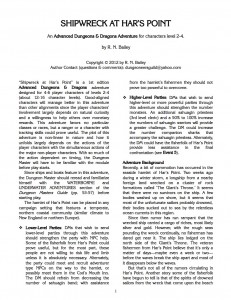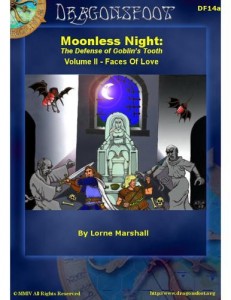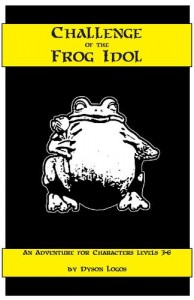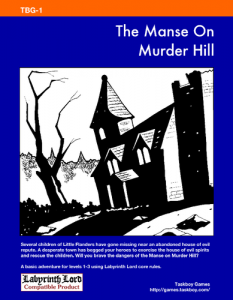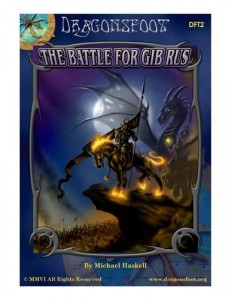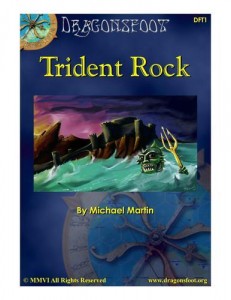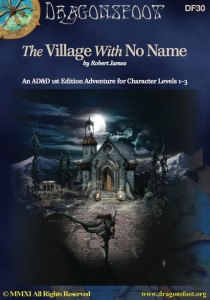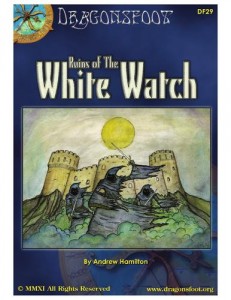by James Maliszewski
Labyrinth Lord/ACKS
Autarch? Grognardia Games?
Levels 1-10
The gates of Dwimmermount are opening. After years of rumors, it is time to discover the secrets of this legendary dungeon for yourself.
This review is based on a DRAFT copy of Dwimmermount. I don’t know how to review a draft. I’m going to ignore that and just jump right in. More disclaimers, product history, and other weasely shit at the end. This module doesn’t break much new ground. It’s got a kind of Vanilla D&D feel to it which is then combined with “Useless Description” syndrome. It’s at its best when channels OD&D through idiosyncratic rules and non-standard elements. It leans HEAVILY to the vanilla. That’s not my bag baby. It DOES generate a certain feeling of continuity that is built up, level after level. That’s a very good thing.
The raw WORD draft copy is 218 pages long. This is BEFORE it goes in to layout. The only part of the book for which layout seems complete is level 1. For comparison, the first dungeon level takes up about 10 pages in the raw WORD doc and the “Layout complete” version of dungeon level 1 would be 11 pages without the map of level 1, and maybe 9 or 10 without the art. To me this means about 220 pages or so of content in the finished product. The actual keyed entries for the dungeon runs about 111 pages long, starting around page 34. Prior to this is mostly background and tacked on to the end are the usual new monsters, new spells, new items, etc.
There’s about five pages on the history of the dungeon. I don’t like long backgrounds and this is just about at the limits of my tolerance level. This section DOES help put the rest of the dungeon in to context though, and it’s NOT in the form of a short story. Putting the dungeon in to context, or rather maybe “Explaining how the dungeon fits together” is a critical part of a megadungeon. There’s a LOT going on in a megadungeon and the DM needs a good overview. The background here does a decent job of helping to do that. For comparison, I also think Stonehell did a decent job while Rappan Athuk sucks donkey balls in this regard. There’s also a six page section later on in the introduction/background which goes level by level through the dungeon and explains all of the factions on that level and what they are doing. This is VERY helpful to getting a feel for what’s going on and is something Rappan Athuk desperately needs. It’s lacking rivalry information though. How do the gnolls, orcs, ghouls Thulians, and Varaze on Level X feel about each other, and outsiders? The plotting and scheming, and a hook or two seem to not be present, which I find disappointing. That would have made the history and faction information really stand out. As is, it still does a good job at it’s intended purpose. It’s approaching my tolerance for length but it maybe that just something you have to get used to in a megadungeon. Stonehell gave this to you in bite-sized chunks and Rappan Athuk ignored it.
The rest of the introduction (~ 20 pages?) is not too useful. The player overview section has some common knowledge about the place as well as some rumors for the party to pick up. That’s probably the best of the rest of the introduction. The adventure seeds are short and not very interesting; mostly fetch quests or some other type of assigned mission. I’m not in favor of Holy Quest or Save the World or Be A Hero type adventures/seeds. The goal of a good seed should be to motivate the PLAYERS not the characters, and these don’t do that. Dropping some hints about the the Throne of the Gods being at the bottom, or something like that, works much better IMO. You remember the last time you gamed with this group of players? What did they want to thwart you? Put that at the bottom and let them know it’s there. You’ll have to beat them off with a stick with all the enthusiasm.
There’s a section on gods/religion which is useless. Just a bunch of gods with two or three sentences each describing some boring-ass typical D&D stuff. Gods of law, gods of chaos, don’t like each other, like each other, blah blah blah boring boring boring. I’m not buying a product to get a realistic world-view of religion. I’m buying a product to help spark my imagination and present to me ideas I’ve not thought of before. Things that get me excited. The same-old same-old view on gods doesn’t do that. “Bob is the god of Craftsmen. He’s friends with the God of Heroes. Their clerics often cooperate. His priests wander with no permanent home.” Compare to the insane AI gods of ASE1 and their random electric temples. “But this isn’t Gonzo!” I don’t care about gonzo. I care about fun. The gods sections adds nothing to D&D and just reiterates things we’ve all seen a thousand times before.
There’s an adventuring home base town presented in the introduction: Muntburg. It’s not very interesting. Just a listing of various buildings, the name and stats of who runs the place, and some text detailing what they can do for adventurers. It feel hollow and without life. The people don’t have much personality and have almost no goals, motivations, or inter-personal relationships presented. The descriptions are just that, descriptions. There’s no seeds present, nothing interesting going on. No rivalries, no love triangles. Nothing to spark a DM’s imagination or springboard them in to something new and fun while in town. The quality of a town or village is based almost entirely on how the villagers relate to each other and to the party. That’s what creates the fun in town. That’s not here. And don’t give me any of that “the DM needs add their own flavor to bring it to life” nonsense. That works when the supplement describes 12 buildings on a page … and even them most of those types have some good stuff to work with . If I’m wading through long descriptions then the designer needs to include some interpersonal relationships, some hooks, and some bizarre things for me to work with.
There’s more throw-away material related to the surrounding countryside/world. Five or six pages describing towns and villages nearby and wilderness areas, etc. More boring descriptions, though short this time. “Winterburg lies in ruins having been destroyed by a marauding army of orcs supposedly led by a demon.” Uh … ok. Lets see, that’s like the 8 millionth time something like that has appeared in a D&D supplement. That’s not interesting. The players have seen that shit before. They seen it A LOT. There’s nothing there to motivate the players to go there OR the DM to expand it. There are a couple of adventuring sites noted, such as the Cursed Chateau and the Tower of the Stargazer. And a temple to Saint Gaxyg the Gray. *sigh*
All that content is just dross. Some kind of value-add to main event: the dungeon. If it’s good it expands and contributes to the fun and if it’s boring it can just be ignored. Kontent is King. The first part of the dungeon is the map. A good map contributes MAJORLY to the adventure. Loops, intersections, varied terrain, same-level stairs, lots of inter-level connections … these things work their ways subtly upon the players, much like the Psychetecture in Mister X. The darkness presses in from all sides and it’s claustrophobic even though you’re in a great chamber. You don’t know … is your map right or are you actually lost? Can you even get out again? What’s down those other hallways? Is something going to come down them and attack from behind, or above or below from that dark hole we left behind us? THE UNKNOWN is everywhere and it probably wants to kill you. Lots of intersections can help with the feeling, as can terrain, varied elevation, same-leve stairs, and LOTS of inter-level connections. Symmetrical dungeons, small dungeons … these things help kill that feeling. The players should never feel safe and never feel as if they’ve explored everything. Bowman and Pogue have done some outstanding maps. Stone did some good maps. The maps for level 6 and 7 seem to do a very good job; they have a complex design with lots of alternate routes. These can allow players to bypass encounters, ambush monsters, and be ambushed by monsters. The rest of the levels fall somewhere else on the scale. They generally do a pretty good job … I think. There’s 70 or so rooms on some levels so it’s going to be hard to NOT do a good job. Level 7, some caverns, would be a high point with lots of terrain, lots of side passages, and lots of interesting features. Level 1 may be the worst, or maybe level 8. Level 1 has hints of symmetry and at least one long linear cavern section, while level 8 has a lot of linear sections with some side rooms. There’s not much on most of the levels in the way of same-level elevation changes/stairs/etc. Many of the maps seem to almost have a generic “dungeon geomorph” feel to them. Except for level 8, the lower level maps seem to feel better than the higher level ones. There’s more variety and they feel less generic. Some o the maps in Castle of the Mad Archmage had this kind of generic feel to them. Something like this: http://www.cartographersguild.com/attachments/dungeon-subterranean-mapping/10510d1234978451-%5Bcc3-dd3%5D-old-school-dungeon-maps-castle-mad-archmage-level02ne.png
It fulfills some technical requirements of being a good map but seems to lack a soul. That’s how many of the upper levels feel. The lower levels tend to do a much better job of presenting an interesting environment to explore. Most maps have about 60 or 70 keyed encounters. Most levels have suck-ass wandering tables. Just a list of wanderers on the level. Kobolds, rats, orcs, spiders, centipedes, fire beetles, slime, and … NPC Party! This is mostly a lost opportunity to add flavor. I like my wanderers to be doing something rather than just be random sword fodder. I’m happy to see an NPC party on the table; those always add a lot of fun to a big dungeon. Basically I want something to add some flavor and not just be another generic monster fight. I appreciate modules which provide a little extra detail in this area. I’ve also got a copy of Shams “What are the monsters doing” table next to me at the table to help out … meaning almost no module provides this extra flavor.
Adventure Time! This is a Maliszewski dungeon. If you’re familiar with his other work them you’ll be mostly familiar with this. It doesn’t deviate much from his usual style. The best parts are when it does. He’s got a kind of bog-standard D&D vibe going on that I don’t really get in to. Knights, brave paladins, holy clerics, etc. Not quite the nonsense I equate with 2E, but more of a non-weird 1E style. IE: Boring. This feel is exacerbated by the O M G LAME room descriptions. He’s got this style where he describes meaningless detail. Something like “This room was once a vestibule” followed by several sentences of what it was once used for and what it once contained. That’s then followed by something like “but it’s now filled with just some wooden scraps and debris.” WTF dude? What’s the point of the description provided? It did nothing to help me run the room or inspire me, the DM, to greatness. There is A LOT of space wasted on this kind of thing. Here’s an example from the text: “6. Trophy Room This large room once contained trophies commemorating Thulian military victories. There were plaques, statues, and other similar ornaments all long since looted and removed to other parts of the fortress. There are indentations in the walls, shelves, and brackets that all give evidence to their former presence. Also in the room are the bodies of two dwarves, both quite fresh though cold to the touch. They wear chain mail and carry axes, but the rest of their belongings (if any) are no longer present.” That’s once of the most useless room descriptions I’ve ever seen. It’s long, boring, and does nothing to help the DM with the room. The vast majority of the rooms have this problem. It’s almost like …. idk, the fluff text that appears in those fluff supplements. I loved the “Eye, Tyrant” book, but its not a dungeon supplement. In a dungeon description I need to be able to find information quickly and I need the information convey general ideas about the room. Things to spark my own creativity. That trophy room description does none of that. It’s just text that has to be slogged through, for fear of missing something, in order to run a boring room. That room did not make my job as a DM easier. It did the opposite. Most of the rooms have this problem. I don’t usually comment on layout/etc, all I generally care about is content. I’m going to make an exception here because the style chosen makes the problem worse. I’m not sure if James or Autarch are doing the layout, but it stinks. It takes these long, boring, meaningless text blocks and turns them in to giant text blocks. I believe the style is called Full Justification. ANY soul in the rooms descriptions are completely killed off by this style. You can’t quickly pick out anything important. It’s just a mass of fully justified text. If you’re lucky there’s a second paragraph. HATE.
There are brief flashes of interesting content scattered throughout. There’s a storeroom with a mini-rule about stirring up the dust. I like the image of stirring up dust, I like mini-rules, and I like the choking/coughing/wandering monster checks it can force. It combines “something non-standard” with an idiosyncratic mechanism for running it. I love that kind of thing in my D&D games. That’s a major part of the fun. There are more than few of these things scattered about. There’s a whole statue thing going on where you can replace the heads of some statues and find rooms of statue heads,all to get some temporary or permanent effect. That’s a good thing … even though the first room in the dungeon totally blows it. The room is full of statues, all with the wrong heads, and replacing them does nothing. Maybe it’s meant to be a red herring. I think it’s a missed opportunity to teach the players that exploring and doing things is rewarded. There are a scattering of these things, like pools that can cause spell levels to be modified, much in the same way that many Gygax products has things which modified attributes permanently. I want a party that’s curios and willing to play with things in the dungeon and I’m happy to see some of that appear in Dwimmermount. I don’t think there’s enough if it. Ultimately it doesn’t feel like the place has a soul. It doesn’t feel alive. There are notations about monsters retreating to their rooms, and some throw-off tactics comments, but even then the dungeon doesn’t seem like a living breathing place. Monsters stand guard. They don’t live. Recall those two dwarf bodies in the trophy room? That’s a good attempt to make the place seem alive. I’m probably giving too negative an impression of the amount of interesting things (IE: not generic monster encounters) but overall that’s the impression have. It’s mostly boring. Boring with a touch of arms/armor mania. Many corpses have a note of what weapon/armor the bodies have an in what condition they are in. Enough of them anyway that it stood out in my mind. Weird.
Many of the new monsters are not new. ‘New’ means ‘not in the LL rulebook’ it seems. Is a Mimic, Babau, or Balor new? I think not. There may be a few actual new ones scattered in but I’m not a monster expert so I wouldn’t know. I like new monsters. They contribute to that air of mystery and the unknown I mentioned earlier. The party doesn’t know what to expect. Do we need to burn it? Is it resistant? Will it fuck up our stats? FEAR OF THE UNKNOWN. Orcs don’t generate that effect. I note that so much of what I’m looking for is an attempt to recreate the feelings of those first few times you played D&D, before it all become known, and therefore boring. This modules monsters don’t really help contribute to that new & fresh feeling that I’m looking for. Nor do the encounters. It’s nostalgic in that it recreates the environment of those early D&D days. You fight kobolds and orcs and undead. But it doesn’t recreate the FEEL of encountering a ghoul for the first time. The fear. The dread, uncertainty and excitement.
The treasure is another poor showing. It’s pretty terrible. In Bryce-speak that means “straight out of the book.” A gem worth 50gp. A gold statue. Earrings. A hairpin. A brooch. A silver chain. That’s crap. It’s one step above the jewelry in G1. Recall, it stated “6 pieces of jewelry each worth 1d6x1000 gp.” The standard in mundane treasure is “does the player want to keep it for his character?” If the answer is yes then it’s a good item. A 1,000 piece fine dinner setting for 12, including olive spoons, oyster forks, and 6 type of forks, with intricate carved handles and long tines, made in gold & platinum with a different gemstone in each setting is the kind of treasure a players says “Fuck Yeah! I’m putting this shit in my house! Can’t wait to invite that asshole Mayor over for dinner!” Earrings: 900gp does none of that. Rare woods, ivory, bolts of cloth … all of that would have been appreciated but are few & far between in Dwimmermount. The magical treasure is just as bad. It’s all straight out of the books. +1 shield. +1 sword. Potion of ESP. +1 plate mail. No descriptions. No unusual effects. B O R I N G. If the player has a character keep a magic item long after more powerful things have been found then you know you’ve done a good job with the description of the earlier item. Any idiot can roll on a magic item table and put in a +1 sword. I’m buying a product to get access to the designers imagination, not because he rolled on the damn table instead of making me do it. There are some exceptions, but again they are few and far between. Too few and too far between. Masks that let you breath poison air. Jumpsuits that mage can wear to lower their AC. Yeah, I know it’s a robe of protection, but it was customized and given a different explanation. See, I’m not THAT hard to please, but you do have to make at least a token effort at imagination. And calling a Javelin of Lighting or Pearl of Power ‘new’ is stretching things a bit. There are a few actual new items and those are very good. But there’s not enough. By far.
Time for the weasel comments.
This is a review of a DRAFT. The final product can change. It’s not complete; there’s a lot I didn’t mention: restocking, NPC parties, etc. Don’t be a dick about something sucking because I didn’t mention it.
I don’t really pay attention to a lot going on in the OSR. I buy modules, do reviews, and look for ideas to steal for my own games. Sometimes something catches my attention and Dwimmermounts kickstarter status did so. I kickstart a lot of adventure modules but I don’t pay much attention after that. The last update on Dwimmermount DID catch my attention, which caused me to review the other mail and do some searches. To be polite, there may have been some confusion during the funding campaign regarding how complete the manuscript was. The project is late and the designer does not seem to be communicating. Update #43 from Autarch suggested that the backers with access to the content play, explore, and enjoy it. I do that through reviews. Hence this one. From what I’ve seen, the situation does not look conducive to a published booklet ever appearing.
I don’t follow blogs like the designers, Grognardia. I did, but then unsubbed. I’m looking for content, like The Dungeon Dozen, and Grognardia is mostly nostalgia. There’s nothing wrong with nostalgia but I get mine through Space: 1970. I’ve seen the designers work in a couple of other products I’ve reviewed, from his dungeons in Fight On! to the Cursed Chateau. They were not my thing. Maybe they’re your thing. IDK. I’m pretty sure I like a play style that is VERY different from the designers. There are not a lot of megadungeons out there. This is one. It doesn’t suck.
This is available on DriveThru.
https://www.drivethrurpg.com/product/133746/Dwimmermount-Labyrinth-Lord-version?affiliate_id=1892600

